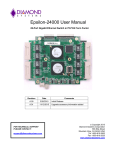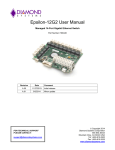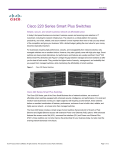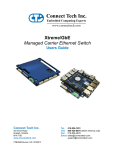Download Epsilon-8100 User Manual - Diamond Systems Corporation
Transcript
Epsilon-8100 User Manual Managed 8-Port Gigabit Ethernet Switch Revision Date A.0 08/12/2014 Initial Release A.1 1/23/2015 Removed POE information A.2 7/30/15 FOR TECHNICAL SUPPORT PLEASE CONTACT: [email protected] Comment Minor updates Copyright 2015 Diamond Systems Corporation 555 Ellis Street Mountain View, CA 94043 USA Tel 1-650-810-2500 Fax 1-650-810-2525 www.diamondsystems.com CONTENTS 1. 2. Important Safe Handling Information .............................................................................................................4 Introduction .......................................................................................................................................................5 2.1 Features .........................................................................................................................................................5 2.1.1 Main Feature List ..................................................................................................................................5 2.1.2 Mechanical and Environmental .............................................................................................................6 2.2 Products .........................................................................................................................................................6 2.3 Cable List .......................................................................................................................................................6 3. Functional Overview .........................................................................................................................................7 3.1 Functional Block Diagram ..............................................................................................................................7 3.2 Board Layout .................................................................................................................................................8 4. Connector and Jumper List .............................................................................................................................9 4.1 Connector and Jumper List ...........................................................................................................................9 4.2 Jumper Block (J15) ........................................................................................................................................9 5. Connector Pinout and Pin Description ........................................................................................................ 10 5.1 Ethernet (J4-J11) ........................................................................................................................................ 10 5.2 Serial Interface (J12) .................................................................................................................................. 10 5.3 Input Power (J14) ....................................................................................................................................... 10 5.4 LED Status Signals (J13) ........................................................................................................................... 11 6. Command Line Interface ............................................................................................................................... 12 6.1 Making an Initial Connection ...................................................................................................................... 12 6.2 Login/Logout Procedures ........................................................................................................................... 12 6.3 Help Utility................................................................................................................................................... 13 6.4 Entering Commands ................................................................................................................................... 13 6.5 General Command Groups ........................................................................................................................ 13 6.5.1 IP Commands .................................................................................................................................... 14 6.5.2 MAC Commands ................................................................................................................................ 14 6.5.3 VLAN/PVLAN Commands ................................................................................................................. 14 6.5.4 dot1x (IEEE Standard for port-based Network Access Control) ........................................................ 15 6.5.5 LACP Commands .............................................................................................................................. 15 6.5.6 LLDP Commands ............................................................................................................................... 15 6.5.7 Access Management Commands ...................................................................................................... 15 6.5.8 Access-list Commands ...................................................................................................................... 15 6.5.9 Logging Commands ........................................................................................................................... 16 6.5.10 Spanning-tree Commands ................................................................................................................. 16 6.5.11 Green-Ethernet Commands ............................................................................................................... 16 6.5.12 Thermal-protect Commands .............................................................................................................. 16 6.5.13 Loop-protect Commands ................................................................................................................... 16 6.5.14 QoS Commands ................................................................................................................................ 17 6.5.15 Privilege Commands .......................................................................................................................... 17 6.5.16 SNMP Commands ............................................................................................................................. 17 6.5.17 SNTP Commands .............................................................................................................................. 18 6.5.18 Radius Server Commands ................................................................................................................. 18 6.5.19 Banner Commands (Defines a login banner) .................................................................................... 18 6.5.20 Terminal Commands.......................................................................................................................... 18 6.5.21 Reload ................................................................................................................................................ 19 6.5.22 Firmware Commands......................................................................................................................... 19 6.5.23 Ping Commands ................................................................................................................................ 19 6.5.24 Debug Commands ............................................................................................................................. 19 6.5.25 Security Commands........................................................................................................................... 19 6.5.26 Monitor ............................................................................................................................................... 19 6.6 Examples .................................................................................................................................................... 20 6.6.1 IP Configuration ................................................................................................................................. 20 6.6.2 Port Configuration .............................................................................................................................. 20 6.6.3 Change Switch Password .................................................................................................................. 20 6.6.4 Set up VLANs .................................................................................................................................... 21 6.6.5 SNMP configuration ........................................................................................................................... 21 6.6.6 Mirroring ............................................................................................................................................. 22 6.6.7 Setup QoS ......................................................................................................................................... 22 6.6.8 Firmware Upgrade ............................................................................................................................. 22 Epsilon-8100 User Manual Revision A.2 www.diamondsystems.com Page 2 6.6.9 Factory defaults ................................................................................................................................. 22 Web Interface ................................................................................................................................................. 23 7.1 Examples .................................................................................................................................................... 23 7.1.1 IP Configuration ................................................................................................................................. 23 7.1.2 Port Configuration .............................................................................................................................. 24 7.1.3 Change Password .............................................................................................................................. 25 7.1.4 Set-up VLANs .................................................................................................................................... 26 7.1.5 SNMP Configuration .......................................................................................................................... 27 7.1.6 Mirroring ............................................................................................................................................. 28 7.1.7 Setup QoS ......................................................................................................................................... 29 7.1.8 Firmware Upgrade ............................................................................................................................. 30 7.1.9 Save Startup Configuration ................................................................................................................ 30 7.1.10 Factory Defaults ................................................................................................................................. 31 7.1.11 Physical Reset ................................................................................................................................... 31 8. Specifications................................................................................................................................................. 32 Appendix A Supported MIBs ........................................................................................................................... 33 7. Epsilon-8100 User Manual Revision A.2 www.diamondsystems.com Page 3 1. IMPORTANT SAFE HANDLING INFORMATION WARNING! ESD-Sensitive Electronic Equipment Observe ESD-safe handling procedures when working with this product. Always use this product in a properly grounded work area and wear appropriate ESD-preventive clothing and/or accessories. Always store this product in ESD-protective packaging when not in use. Safe Handling Precautions The Epsilon-8100 board contains a high density connector with many connections to sensitive electronic components. This creates many opportunities for accidental damage during handling, installation and connection to other equipment. The list here describes common causes of failure found on boards returned to Diamond Systems for repair. This information is provided as a source of advice to help you prevent damaging your Diamond (or any vendor’s) boards. ESD damage – This type of damage is usually almost impossible to detect, because there is no visual sign of failure or damage. The symptom is that the board eventually simply stops working, because some component becomes defective. Usually the failure can be identified and the chip can be replaced. To prevent ESD damage, always follow proper ESD-prevention practices when handling computer boards. Damage during handling or storage – On some boards we have noticed physical damage from mishandling. A common observation is that a screwdriver slipped while installing the board, causing a gouge in the PCB surface and cutting signal traces or damaging components. Another common observation is damaged board corners, indicating the board was dropped. This may or may not cause damage to the circuitry, depending on what is near the corner. Most of our boards are designed with at least 25 mils clearance between the board edge and any component pad, and ground / power planes are at least 20 mils from the edge to avoid possible shorting from this type of damage. However these design rules are not sufficient to prevent damage in all situations. A third cause of failure is when a metal screwdriver tip slips, or a screw drops onto the board while it is powered on, causing a short between a power pin and a signal pin on a component. This can cause overvoltage / power supply problems described below. To avoid this type of failure, only perform assembly operations when the system is powered off. Sometimes boards are stored in racks with slots that grip the edge of the board. This is a common practice for board manufacturers. However our boards are generally very dense, and if the board has components very close to the board edge, they can be damaged or even knocked off the board when the board tilts back in the rack. Diamond recommends that all our boards be stored only in individual ESD-safe packaging. If multiple boards are stored together, they should be contained in bins with dividers between boards. Do not pile boards on top of each other or cram too many boards into a small location. This can cause damage to connector pins or fragile components. Power supply wired backwards – Our power supplies and boards are not designed to withstand a reverse power supply connection. This will destroy each IC that is connected to the power supply (i.e. almost all ICs). In this case the board will most likely will be unrepairable and must be replaced. A chip destroyed by reverse power or by excessive power will often have a visible hole on the top or show some deformation on the top surface due to vaporization inside the package. Check twice before applying power! Overvoltage on analog input – If a voltage applied to an analog input exceeds the design specification of the board, the input multiplexor and/or parts behind it can be damaged. Most of our boards will withstand an erroneous connection of up to 35V on the analog inputs, even when the board is powered off, but not all boards, and not in all conditions. Overvoltage on analog output – If an analog output is accidentally connected to another output signal or a power supply voltage, the output can be damaged. On most of our boards, a short circuit to ground on an analog output will not cause trouble. Overvoltage on digital I/O line – If a digital I/O signal is connected to a voltage above the maximum specified voltage, the digital circuitry can be damaged. On most of our boards the acceptable range of voltages connected to digital I/O signals is 0-5V, and they can withstand about 0.5V beyond that (-0.5 to 5.5V) before being damaged. However logic signals at 12V and even 24V are common, and if one of these is connected to a 5V logic chip, the chip will be damaged, and the damage could even extend past that chip to others in the circuit. Epsilon-8100 User Manual Revision A.2 www.diamondsystems.com Page 4 2. INTRODUCTION Epsilon-8100 is a managed, 8-Port Gigabit Ethernet Switch with wide power supply voltage input and a serial management port. Epsilon-8100 offers 10/100/1000Mbps copper twisted pair ports on a PC/104 format board. An RS-232 interface is provided to enable communication between the on-board management microcontroller and a host processor through a Command Line Interface (CLI). A wide-range DC power supply is built into the board to allow it to be used with industrial power sources as well as the typical embedded +5V supply. Highly Advanced Gigabit Ethernet Switch Epsilon-8100 is an 8-port Gigabit Ethernet switch in the compact PC/104 form factor. Epsilon-8100 operates standalone, but can be included in any PC/104 board stack. Layer 2+ Managed Switch Epsilon-8100’s Ethernet switch chip includes a built-in microcontroller for configuration and management. It can be accessed either through the on-board RS-232 port or one of the Ethernet ports. Wide Power DC/DC Power Supply Epsilon-8100 is powered through a wide voltage +5-36V DC/DC power supply input. Rugged Design Extended temperature operation of -40°C to +85°C is tested and guaranteed. Epsilon-8100 was designed with harsh applications in mind. Latching connectors provide increased reliability. Software Support The switch is ready to plug into your application without any driver installation or firmware upgrades. A web interface and a CLI provide an intuitive GUI for configuring and managing the switch. 2.1 Features 2.1.1 Main Feature List 8 10/100/1000Mbps copper Ethernet ports with nonblocking wire-speed performance Dual leaky bucket policers with remarking and statistics Jumbo frame support at all speeds 8K MAC addresses and 4K VLANs (IEEE 802.1Q), as well as 8K IPv4 and IPv6 multicast group support Flexible link aggregation support based on Layer-2 through Layer-4 information (IEEE 802.3ad) Multicast and broadcast storm control, as well as flooding control Rapid Spanning Tree protocol (RSTP) and MSTP 8 priorities and 8 QoS queues per port with scheduling Shaping/policing per queue and per port Multiple protocol support: IEEE 802.1d, IEEE 802.1w, IEEE 802.1s, and IEEE 802.1X Built-in 416MHz MIPS 24KEC microcontroller for configuration and management RS-232 serial port provides out-of-band management interface Can operate autonomously or in conjunction with a host SBC Wide input voltage range: +5 to +36VDC input PC/104 form factor (3.55 x 3.775 in.) -40°C to +85°C (-40°F to +185°F) operating temperature Epsilon-8100 User Manual Revision A.2 www.diamondsystems.com Page 5 2.1.2 Mechanical and Environmental PC/104 compliant form factor including: Board dimensions Mounting holes Component and heat sink height -40°C to +85°C ambient operating temperature 2.2 Products The table below lists the model number and description for the Epsilon-8100 and its associated cable kit. Model Number Description 8-Port Gigabit Ethernet Switch with heatspreader, PC/104 form factor, -40°C to +85°C operating temperature 8-Port Gigabit Ethernet Switch with heatsink, PC/104 form factor, -40°C to +85°C operating temperature Epsilon-8100 Cable Kit EPS-8100-XT EPS-8100 C-EPS8000-KIT 2.3 Cable List The contents of the Epsilon-8100 Cable Kit, C-EPS8000-KIT, are shown below. Number Part Number 1 2 3 6981052 6981051 6981050 Quantity 8 1 1 Cable Description Ethernet cable (1 per port) Power cable Serial cable PC/104™ and PC/104-Plus™ are trademarks of the PC/104 Embedded Consortium. All other trademarks are the property of their respective owners. Epsilon-8100 User Manual Revision A.2 www.diamondsystems.com Page 6 3. FUNCTIONAL OVERVIEW Functional Block Diagram Serial port Conn VSC7428 8-Port GigE Switch Gigabit Ethernet Connector (x4) DDR2 SDRAM Magnetics Magnetics Ports 1,3,5,7 Gigabit Ethernet Connector (x4) SPI FLASH Ports 2,4,6,8 3.1 RS-232 Tranceiver LED Header Figure 1. Functional Block Diagram Epsilon-8100 is an 8-Port managed Gigabit Ethernet switch module offering 10/100/1000Mbps copper twisted pair ports on a PC/104 form factor board. Epsilon-8100 operates standalone, requiring no connection to a single board computer in the stack. Epsilon-8100 is a Layer 2+ managed Ethernet switch with built-in microcontroller and memory for configuration and management. The Flash memory holds dual application images along with the boot code, The SRAM is used for program execution and storing the MAC addresses. The EEPROM holds the configuration parameters. . An RS-232 interface is provided to enable communication between the on-board management microcontroller and a host processor through a CLI interface. The microcontroller is also accessible through one of the Ethernet ports via a web management interface. Power is provided through the +5-36VDC wide-range DC power supply built into the board, enabling use with industrial power sources. Epsilon-8100 User Manual Revision A.2 www.diamondsystems.com Page 7 3.2 Board Layout The following photo shows the locations for all connectors and jumpers which are described in the next sections. Power In LED J15 LAN1 LAN2 LAN3 LAN4 LAN5 LAN6 LAN7 LAN8 RS-232 Figure 2. Epsilon-8100 Connectors and Jumpers Epsilon-8100 User Manual Revision A.2 www.diamondsystems.com Page 8 4. CONNECTOR AND JUMPER LIST 4.1 Connector and Jumper List The following table summarizes the functions of Epsilon-8100’s interface connectors and jumper. Refer to Figure 2 for the locations of these connectors on Epsilon-8100. Signal functions relating to all of Epsilon-8100’s interface connectors are discussed in greater detail in Section 6 of this document. Other connectors and jumper blocks on Epsilon-8100 are reserved for Diamond’s use only. Connector LAN1-8 RS-232 LED Power In J15 4.2 Function Ethernet (x8) RS-232 Serial Interface LED Status Signals and Resets Wide voltage power input Jumper Block J15 Jumper Block (J15) The following table summarizes the functions of Epsilon-8100’s jumper block, J15. Refer to the Figure 2 for the location of J15 on Epsilon-8100. Jumper J15 Pins 1&2 3&4 5&6 Function Reset: Install jumper and power on to reset the switch Factory Use Only Factory Use Only Epsilon-8100 User Manual Revision A.2 www.diamondsystems.com Page 9 5. CONNECTOR PINOUT AND PIN DESCRIPTION 5.1 Ethernet (J4-J11) Epsilon-8100 contains eight right-angle, locking pin headers for the eight Ethernet ports. Each port has the same style and pin out. Each signal is associated with a particular color inside of the Diamond Systems cable part number 6981052. The color coding for this cable follows the TIA/EIA 568B standard. DD+ DC+ DB+ DA+ Gnd 1 3 5 7 9 2 4 6 8 10 DDDCDBDAGnd Connector Type: 2mm dual row right-angle, locking pin header with tin plating Mating Connector: JST Sales America PUDP-10V-S housing with SPUD-002T-P0.5 terminals 5.2 Serial Interface (J12) Epsilon-8100 contains an RS-232 connector, J12, which connects the on-board microcontroller to an external serial port. 1 2 3 Ground TxD Out RxD In Connector Type: 2mm single row right-angle, locking pin header with tin plating Mating Connector: Molex Connector 35507-0300 housing with 50212-8100 terminals 5.3 Input Power (J14) Input power is supplied either through the dedicated 4-pin connector (J14). The pin out for J14 is: 1 2 3 4 V In Ground Ground V In Connector Type: 2mm single row right-angle, locking pin header with tin plating Mating Connector: Molex Connector 35507-0400 housing with 50212-8100 terminals Epsilon-8100 User Manual Revision A.2 www.diamondsystems.com Page 10 5.4 LED Status Signals (J13) Connector J13 provides access to the Ethernet LED signals for each of the eight ports. This connector has duplicate connections for Reset control input. LEDs may be directly connected to these signals without requiring any current-limiting resistors. The 3.3V supply required for the LEDs is also provided by the connector. The control signals pull the LED pin low to turn it on. To use J13 to operate an LED externally to Epsilon-8100, connect the LED’s anode (+) to one of the 3.3V pins (J13 pin 1 or 2). Connect the LED’s cathode (-) to the corresponding control signal on connector J13. The on board activity LED is a green LED (LTST-C190GKT) with a typical forward voltage of 2.1V and a maximum of 2.6V with a 20mA If. The on board speed LED is a Yellow LED (LTST-C190YKT) with the same characteristics. The control signal is capable of sinking a maximum of 18mA. The series resistor is 330 ohms, which gives an If of about 3.6mA. When an LED is connected to connector J13, it is in parallel with the on board LED. If the external LED has about the same forward voltage, the current will be cut in half. If the external LED has a lower forward voltage, it will dominate the on-board LED and be brighter. Therefore, if the external LED is not bright enough use an external LED with a lower forward voltage. Reset: Causes a reset of the switch when connected to ground. SW_GPIO1 and SW_GPIO2 - provide control for user defined LEDs. 3.3V SW_GPIO1 DefaultPort 1 Speed Ground Port 3 Speed Port 5 Speed Ground Port 7 Speed Port 8 Activity Ground Port 6 Activity Port 4 Activity Ground Port 2 Activity 29 27 25 23 21 19 17 15 13 11 9 7 5 3 1 30 28 26 24 22 20 18 16 14 12 10 8 6 4 2 3.3V SW_GPIO0 ResetPort 1 Activity Port 3 Activity Ground Port 5 Activity Port 7 Activity Ground Port 8 Speed Port 6 Speed Ground Port 4 Speed Port 2 Speed Ground Connector Type: 2mm dual row right-angle, locking pin header with tin plating Mating Connector: JST Sales America PUDP-30V-S housing with SPUD-002T-P0.5 terminals The following diagram shows how to connect external LEDS to connector J13: Epsilon-8100 User Manual Revision A.2 www.diamondsystems.com Page 11 6. COMMAND LINE INTERFACE The command line interface (CLI) is a modal, line-based interface with no screen editing features where commands are executed immediately upon end-of-line. The CLI can be accessed directly via the serial connection. The user must log in before CLI commands can be executed. 6.1 Making an Initial Connection Serial line configuration: 38400 baud 8 bit data No parity 1 stop bit Login information Username: admin Password: {none} The board is shipped with an IP address of 192.168.1.60. This allows the WEB interface to be accessed at that address. The IP address, mask and gateway must be set according to your environment, or you can enable IP and DHCP if your environment includes a DHCP server. For example: # configure terminal (config)# interface vlan 1 (config-if-vlan)# ip address dhcp (config-if-vlan)# end Below example depicts configuration of static IP address, # configure terminal (config)# interface vlan 1 (config-if-vlan)# ip address 192.168.1.60 255.255.0.0 (config-if-vlan)# end Display the IP address to confirm: # show ip interface brief Vlan Address Method Status ---- -------------------- -------- -----1 192.168.1.60 Manual UP # 6.2 Login/Logout Procedures To get access to the CLI you must login by entering a username and password. You will automatically be queried about the password. The password is configurable. You may logout at any time and at any context level using the exit command Epsilon-8100 User Manual Revision A.2 www.diamondsystems.com Page 12 6.3 Help Utility You may get help by pressing the ? key or entering help. The help info depends on the context: At top level, a list of command groups is displayed. At group level, a list of the command syntaxes for the current group is displayed. If the help command is issued for a specific command, the command syntax and a description of the command are shown. 6.4 Entering Commands Commands are not case-sensitive. You may use the horizontal arrow-keys ← and → to move the cursor within the command you are entering. You may use the backspace key (provided you are using a terminal that sends the BS (8) character when the backspace key is pressed) to delete chars from the command you are entering. You may use the vertical arrow-keys ↑ and ↓ to scroll through a command history buffer of the latest 20 commands issued. 6.5 General Command Groups The following groups of general commands are available in the command line interface (CLI). # ? clear configure copy debug delete dir disable do dot1x enable exit firmware help ip logout more no ping reload send show terminal Reset functions Enter configuration mode Copy from source to destination Debugging functions Delete one file in flash: file system Directory of all files in flash: file system Turn off privileged commands To run exec commands in config mode IEEE Standard for port-based Network Access Control Turn on privileged commands Exit from EXEC mode Firmware upgrade/swap Description of the interactive help system IPv4 commands Exit from EXEC mode Display file Negate a command or set its defaults Send ICMP echo messages Reload system. Send a message to other tty lines Show running system information Set terminal line parameters # Epsilon-8100 User Manual Revision A.2 www.diamondsystems.com Page 13 6.5.1 IP Commands (config)# ip http secure-redirect (config)# ip http secure-server (config)# ip igmp snooping (config)# ip igmp snooping vlan <v_vlan_list> (config)# ip igmp unknown-flooding (config)# ip route <v_ipv4_addr> <v_ipv4_netmask> <v_ipv4_gw> (config)# ip dhcp retry interface vlan <vlan_id> (config)# no ip http secure-redirect (config)# no ip http secure-server (config)# no ip igmp snooping (config)# no ip igmp snooping vlan [ <v_vlan_list> ] (config)# no ip igmp unknown-flooding (config)# no ip route <v_ipv4_addr> <v_ipv4_netmask> <v_ipv4_gw> # clear ip arp # clear ip igmp snooping [ vlan <v_vlan_list> ] statistics # clear ip statistics [ system ] [ interface vlan <v_vlan_list> ] [ icmp ] [ icmp-msg <type> ] # show ip arp # show ip http server secure status # show ip igmp snooping [ vlan <v_vlan_list> ] [ group-database [ interface ( <port_type> [ <v_port_type_list> ] ) ] [ sfm-information ] ] [ detail ] # show ip igmp snooping mrouter [ detail ] # show ip interface brief # show ip route # show ip statistics [ system ] [ interface vlan <v_vlan_list> ] [ icmp ] [ icmp-msg <type> ] 6.5.2 MAC Commands (config)# mac address-table aging-time <v_0_10_to_1000000> (config)# mac address-table static <v_mac_addr> vlan <v_vlan_id> interface ( <port_type> [ <v_port_type_list> ] ) (config)# no mac address-table aging-time (config)# no mac address-table aging-time <v_0_10_to_1000000> (config)# no mac address-table static <v_mac_addr> vlan <v_vlan_id> interface ( <port_type> [ <v_port_type_list> ] ) # clear mac address-table # show mac address-table [ conf | static | aging-time | { { learning | count } [ interface ( <port_type> [ <v_port_type_list> ] ) ] } | { address <v_mac_addr> [ vlan <v_vlan_id> ] } | vlan <v_vlan_id_1> | interface ( <port_type> [ <v_port_type_list_1> ] ) ] 6.5.3 VLAN/PVLAN Commands (config)# interface vlan <vlist> (config)# no interface vlan <vlist> (config)# no vlan { { ethertype s-custom-port } | <vlan_list> } (config)# vlan <vlist> (config)# vlan ethertype s-custom-port <etype> # show interface vlan [ <vlist> ] # show pvlan [ <pvlan_list> ] # show pvlan isolation [ interface ( <port_type> [ <plist> ] ) ] # show vlan [ id <vlan_list> | name <name> | brief ] # show vlan status [ interface ( <port_type> [ <plist> ] ) ] [ combined | admin | nas | mvr | voice-vlan | mstp | erps | vcl | evc | gvrp | all | conflicts ] Epsilon-8100 User Manual Revision A.2 www.diamondsystems.com Page 14 6.5.4 dot1x (IEEE Standard for port-based Network Access Control) (config)# dot1x authentication timer inactivity <v_10_to_100000> (config)# dot1x authentication timer re-authenticate <v_1_to_3600> (config)# dot1x re-authentication (config)# dot1x system-auth-control (config)# dot1x timeout quiet-period <v_10_to_1000000> (config)# dot1x timeout tx-period <v_1_to_65535> (config)# no dot1x authentication timer inactivity (config)# no dot1x authentication timer re-authenticate (config)# no dot1x re-authentication (config)# no dot1x system-auth-control (config)# no dot1x timeout quiet-period (config)# no dot1x timeout tx-period # clear dot1x statistics [ interface ( <port_type> [ <v_port_type_list> ] ) ] # dot1x initialize [ interface ( <port_type> [ <plist> ] ) ] # show dot1x statistics { eapol | radius | all } [ interface ( <port_type> [ <v_port_type_list> ] ) ] # show dot1x status [ interface ( <port_type> [ <v_port_type_list> ] ) ] [ brief ] 6.5.5 LACP Commands (config)# lacp system-priority <v_1_to_65535> (config)# no lacp system-priority <v_1_to_65535> # clear lacp statistics # show lacp { internal | statistics | system-id | neighbour } 6.5.6 LLDP Commands (config)# lldp holdtime <val> (config)# lldp reinit <val> (config)# lldp timer <val> (config)# lldp transmission-delay <val> (config)# no lldp holdtime (config)# no lldp reinit (config)# no lldp timer (config)# no lldp transmission-delay # clear lldp statistics # show lldp eee [ interface ( <port_type> [ <v_port_type_list> ] ) ] # show lldp neighbors [ interface ( <port_type> [ <v_port_type_list> ] ) ] # show lldp statistics [ interface ( <port_type> [ <v_port_type_list> ] ) ] 6.5.7 Access Management Commands (config)# access management <access_id> <access_vid> <start_addr> [ to <end_addr> ] { [ web ] [ snmp ] [ telnet ] | all } (config)# no access management (config)# no access management <access_id_list> # clear access management statistics # show access management [ statistics | <access_id_list> ] 6.5.8 Access-list Commands (config)# access-list rate-limiter [ <rate_limiter_list> ] { pps <pps_rate> | 100pps <pps100_rate> | kpps <kpps_rate> | 100kbps <kpbs100_rate> } (config)# default access-list rate-limiter [ <rate_limiter_list> ] (config)# no access-list ace <ace_list> # clear access-list ace statistics # show access-list [ interface [ ( <port_type> [ <v_port_type_list> ] ) ] ] [ rate-limiter [ <rate_limiter_list> ] ] [ ace statistics [ <ace_list> ] ] # show access-list ace-status [ static ] [ link-oam ] [ loop-protect ] [ dhcp ] [ ptp ] [ upnp ] [ arp-inspection ] [ evc ] [ mep ] [ ipmc ] [ ip-source-guard ] [ ip-mgmt ] [ conflicts ] [ switch <switch_list> ] Epsilon-8100 User Manual Revision A.2 www.diamondsystems.com Page 15 6.5.9 Logging Commands (config)# logging host <v_word45> (config)# logging level { info | warning | error } (config)# logging on (config)# no logging host (config)# no logging on # clear logging [ info ] [ warning ] [ error ] [ switch <switch_list> ] # show logging <log_id> [ switch <switch_list> ] # show logging [ info ] [ warning ] [ error ] [ switch <switch_list> ] 6.5.10 Spanning-tree Commands (config)# spanning-tree aggregation (config)# spanning-tree edge bpdu-filter (config)# spanning-tree edge bpdu-guard (config)# spanning-tree mode { stp | rstp | mstp } (config)# spanning-tree recovery interval <interval> (config)# spanning-tree transmit hold-count <holdcount> (config)# no spanning-tree edge bpdu-filter (config)# no spanning-tree edge bpdu-guard (config)# no spanning-tree mode (config)# no spanning-tree recovery interval (config)# no spanning-tree transmit hold-count # clear spanning-tree { { statistics [ interface ( <port_type> [ <v_port_type_list> ] ) ] } | { detected-protocols [ interface ( <port_type> [ <v_port_type_list_1> ] ) ] } } # show spanning-tree [ summary | active | { interface ( <port_type> [ <v_port_type_list> ] ) } | { detailed [ interface ( <port_type> [ <v_port_type_list_1> ] ) ] } | { mst [ configuration | { <instance> [ interface ( <port_type> [ <v_port_type_list_2> ] ) ] } ] } ] 6.5.11 Green-Ethernet Commands (config)# green-ethernet eee optimize-for-power (config)# green-ethernet led interval <v_0_to_24> intensity <v_0_to_100> (config)# green-ethernet led on-event { [ link-change <v_0_to_65535> ] [ error ] }*1 (config)# no green-ethernet eee optimize-for-power (config)# no green-ethernet led interval <0~24> (config)# no green-ethernet led on-event [ link-change ] [ error ] # show green-ethernet [ interface ( <port_type> [ <port_list> ] ) ] # show green-ethernet eee [ interface ( <port_type> [ <port_list> ] ) ] # show green-ethernet energy-detect [ interface ( <port_type> [ <port_list> ] ) ] # show green-ethernet short-reach [ interface ( <port_type> [ <port_list> ] ) ] 6.5.12 Thermal-protect Commands (config)# no thermal-protect prio <prio_list> (config)# thermal-protect prio <prio_list> temperature <new_temp> # show thermal-protect [ interface ( <port_type> [ <port_list> ] ) ] 6.5.13 Loop-protect Commands (config)# loop-protect (config)# loop-protect shutdown-time <t> (config)# loop-protect transmit-time <t> (config)# no loop-protect (config)# no loop-protect shutdown-time (config)# no loop-protect transmit-time # show loop-protect [ interface ( <port_type> [ <plist> ] ) ] Epsilon-8100 User Manual Revision A.2 www.diamondsystems.com Page 16 6.5.14 QoS Commands (config)# no qos qce <qce_id_range> (config)# no qos storm { unicast | multicast | broadcast } (config)# qos storm { unicast | multicast | broadcast } { { <rate> [ kfps ] } | { 1024 kfps } } # show qos [ { interface [ ( <port_type> [ <port> ] ) ] } | wred | { maps [ dscp-cos ] [ dscp-ingress-translation ] [ dscp-classify ] [ cos-dscp ] [ dscp-egress-translation ] } | storm | { qce [ <qce> ] } ] 6.5.15 Privilege Commands (config)# privilege { exec | configure | config-vlan | line | interface | if-vlan | ipmc-profile | snmps-host | stp-aggr | dhcp-pool | rfc2544-profile } level <privilege> <cmd> (config)# no privilege { exec | configure | config-vlan | line | interface | if-vlan | ipmc-profile | snmps-host | stp-aggr | dhcp-pool | rfc2544-profile } level <0-15> <cmd> # show privilege 6.5.16 SNMP Commands (config)# snmp-server (config)# snmp-server access <group_name> model { v1 | v2c | v3 | any } level { auth | noauth | priv } [ read (config)# <view_name> ] [ write <write_name> ] (config)# snmp-server community v2c <comm> [ ro | rw ] (config)# snmp-server community v3 <v3_comm> [ <v_ipv4_addr> <v_ipv4_netmask> ] (config)# snmp-server contact <v_line255> (config)# snmp-server engine-id local <engineID> (config)# snmp-server host <conf_name> (config)# snmp-server location <v_line255> (config)# snmp-server security-to-group model { v1 | v2c | v3 } name <security_name> group <group_name> (config)# snmp-server trap (config)# snmp-server user <username> engine-id <engineID> [ { md5 <md5_passwd> | sha <sha_passwd> } [ priv { des | aes } <priv_passwd> ] ] (config)# snmp-server version { v1 | v2c | v3 } (config)# snmp-server view <view_name> <oid_subtree> { include | exclude } (config)# no snmp-server (config)# no snmp-server access <group_name> model { v1 | v2c | v3 | any } level { auth | noauth | priv } (config)# no snmp-server community v2c (config)# no snmp-server community v3 <community> (config)# no snmp-server contact (config)# no snmp-server engined-id local (config)# no snmp-server host <conf_name> (config)# no snmp-server location (config)# no snmp-server security-to-group model { v1 | v2c | v3 } name <security_name> (config)# no snmp-server trap (config)# no snmp-server user <username> engine-id <engineID> (config)# no snmp-server version (config)# no snmp-server view <view_name> <oid_subtree> # show snmp # show snmp access [ <group_name> { v1 | v2c | v3 | any } { auth | noauth | priv } ] # show snmp community v3 [ <community> ] # show snmp host [ <conf_name> ] [ system ] [ switch ] [ interface ] [ aaa ] # show snmp mib context # show snmp mib ifmib ifIndex # show snmp security-to-group [ { v1 | v2c | v3 } <security_name> ] # show snmp user [ <username> <engineID> ] # show snmp view [ <view_name> <oid_subtree> ] Epsilon-8100 User Manual Revision A.2 www.diamondsystems.com Page 17 6.5.17 SNTP Commands (config)# sntp (config)# sntp server ip-address { <ipv4_var> } (config)# no sntp (config)# no sntp server # show sntp status 6.5.18 Radius Server Commands (config)# radius-server attribute 32 <id> (config)# radius-server attribute 4 <ipv4> (config)# radius-server deadtime <minutes> (config)# radius-server host <host_name> [ auth-port <auth_port> ] [ acct-port <acct_port>] [ timeout <seconds> ] [ retransmit <retries> ] [ key <key> ] (config)# radius-server key <key> (config)# radius-server retransmit <retries> (config)# radius-server timeout <seconds> (config)# no radius-server attribute 32 (config)# no radius-server attribute 4 (config)# no radius-server deadtime (config)# no radius-server host <host_name> [ auth-port <auth_port> ] [ acct-port <acct_port> ] (config)# no radius-server key (config)# no radius-server retransmit (config)# no radius-server timeout # show radius-server [ statistics ] # show running-config [ all-defaults ] # show running-config feature <feature_name> [ all-defaults ] # show running-config interface ( <port_type> [ <list> ] ) [ all-defaults ] # show running-config interface vlan <list> [ all-defaults ] # show running-config line { console | vty } <list> [ all-defaults ] # show running-config vlan <list> [ all-defaults ] 6.5.19 Banner Commands (Defines a login banner) (config)# banner [ motd ] <banner> (config)# banner exec <banner> (config)# banner login <banner> (config)# no banner [ motd ] (config)# no banner exec (config)# no banner login 6.5.20 Terminal Commands (config)# no terminal editing (config)# no terminal exec-timeout (config)# no terminal history size (config)# no terminal length (config)# no terminal width # terminal editing # terminal exec-timeout <min> [ <sec> ] # terminal help # terminal history size <history_size> # terminal length <lines> # terminal width <width> Epsilon-8100 User Manual Revision A.2 www.diamondsystems.com Page 18 6.5.21 Reload reload { { { cold | warm } [ sid <usid> ] } | { defaults [ keep-ip ] } } 6.5.22 Firmware Commands # firmware swap # firmware upgrade <tftpserver_path_file> 6.5.23 Ping Commands # ping ip <v_ip_addr> [ repeat <count> ] [ size <size> ] [ interval <seconds> ] 6.5.24 Debug Commands (config)# no debug prompt (config)# line { <0~16> | console 0 | vty <0~15> } # no debug prompt # debug prompt <debug_prompt> 6.5.25 Security Commands (config)# no aaa authentication login { console | telnet | ssh | http } (config)# password encrypted <encry_password> (config)# password none (config)# password unencrypted <password> (config)# enable password [ level <priv> ] <password> (config)# enable secret { 0 | 5 } [ level <priv> ] <password> (config)# no enable password [ level <priv> ] (config)# no enable secret { [ 0 | 5 ] } [ level <priv> ] # show aaa # show port-security port [ interface ( <port_type> [ <v_port_type_list> ] ) ] # show port-security switch [ interface ( <port_type> [ <v_port_type_list> ] ) ] (config)# aaa authentication login { console | telnet | ssh | http } { { local | radius | tacacs } [ { local | radius | tacacs } [ { local | radius | tacacs } ] ] } 6.5.26 Monitor (config)# monitor destination interface <port_type> <in_port_type> (config)# monitor source { { interface ( <port_type> [ <v_port_type_list> ] ) } | { cpu [<cpu_switch_range> ] } } { both | rx | tx } (config)# no monitor destination (config)# no monitor source { { interface ( <port_type> [ <v_port_type_list> ] ) } | { cpu [ <cpu_switch_range> ] } } Epsilon-8100 User Manual Revision A.2 www.diamondsystems.com Page 19 6.6 Examples 6.6.1 IP Configuration Below example depicts configuration of static IP address, # configure terminal (config)# interface vlan 1 (config-if-vlan)# ip address 192.168.1.60 255.255.0.0 (config-if-vlan)# end Display the IP address to confirm: # show ip interface brief Vlan Address Method Status ---- -------------------- -------- -----1 192.168.1.60 Manual UP # 6.6.2 Port Configuration Individual ports can be configured to different speed. Following example shows configuring speed as 100 Mbps for port 1. # configure terminal (config)# interface GigabitEthernet 1/1 (config-if)# speed ? 10 10Mbps 100 100Mbps 1000 1Gbps auto Auto negotiation (config-if)# speed 100 (config-if)# end # 6.6.3 Change Switch Password Following example shows setting of new password, # configure terminal (config)# password unencrypted <password> (config)# exit # Epsilon-8100 User Manual Revision A.2 www.diamondsystems.com Page 20 6.6.4 Set up VLANs Virtual LANs (VLANs) are used to divide the network into separate logical areas. VLANs can also be considered as broadcast domains. Following example shows setting up VLAN2 and VLAN3 with switch port mode set to access. #configure terminal (config)# vlan 2 (config)# vlan 3 Set access port, in this case it’s assumed that port 1~3 are connected to PC. The PVID of each port is different. #configure terminal (config)# interface GigabitEthernet (Config-if)# switchport mode access (Config-if)# switchport access vlan (config)# exit (config)# interface GigabitEthernet (Config-if)# switchport mode access (Config-if)# switchport access vlan (config)# exit 1/2 2 1/3 3 To verify created VLAN # show vlan VLAN Name ---- -------------------------------1 default 2 VLAN0002 3 VLAN0003 Interfaces ---------Gi 1/1,4-8 Gi 1/2 Gi 1/3 As shown above, VLAN2 is created with the name VLAN0002 and a port 2 assigned to VLAN2. Similarly port 3 assigned to VLAN0003. Remaining ports 1 & 4 to 8 are by default assigned to VLAN 1 6.6.5 SNMP configuration Following example depicts the configuration of SNMP, To enable the SNMP mode operation # configure terminal (config)# snmp-server (config)# exit # SNMP Trap configuration, # configure terminal (config)# snmp-server host Example (config-snmp-host)# host 192.168.1.20 (config-snmp-host)# exit (config)# exit # Epsilon-8100 User Manual Revision A.2 www.diamondsystems.com Page 21 6.6.6 Mirroring For debugging network problems or monitoring network traffic, the switch system can be configured to mirror frame from multiple ports to a mirror port. Following example depicts Mirror traffic of Port 2 and 3 (Rx) & 4 to 8 (Rx) to Port 1. # configure terminal (config)# monitor destination interface GigabitEthernet 1/1 (config)# monitor source interface GigabitEthernet 1/2-3 rx (config)# monitor source interface GigabitEthernet 1/4-8 tx 6.6.7 Setup QoS Quality of Service (QoS) refers to the capability of a network to provide better service to selected network traffic over various technologies, including Frame Relay, Asynchronous Transfer Mode (ATM), Ethernet and 802.1 networks, SONET, and IP-routed networks that may use any or all of these underlying technologies. Following example shows setting up the QoS, all traffic coming on port 1 is mapped to QoS class (CoS) 2 and PCP is set as 1. # configure terminal (config)# interface GigabitEthernet 1/1 (config-if)# qos cos 2 (config-if)# qos pcp 1 (config-if)# end 6.6.8 Firmware Upgrade A new WebStax image can be downloaded using the CLI. Copy the Epsilon-8100.dat file to a TFTP server and use the firmware upgrade command to download the file. # firmware upgrade tftp://<ip_address>/<path>/Epsilon-8100.dat # 6.6.9 Factory defaults User can reset the configuration of the switch by below command. Only the IP configuration is retained. # reload defaults # Note: To load the factory default configuration including the IP address, follow steps explained in section 7.1.11 Epsilon-8100 User Manual Revision A.2 www.diamondsystems.com Page 22 7. WEB INTERFACE The web interface offers an alternate user interface to the CLI. The web interface is in-band and requires use of one of the Ethernet ports. This port provides simultaneous web management and normal usage. The same commands with the same functionality can be accessed via either interface. From the WEB interface it is possible to, among other things: Set port mode Enable/disable flow control Configure simple port-based VLAN Configure aggregation groups Configure LACP parameters Configure QoS Configure SNMP Mirroring Read and clear statistics counters Monitor LACP status Configure and monitor 802.1X Configure and monitor IGMP snooping (if defined for switch device) Configure source-IP address and DHCP server filter Upgrade software 7.1 Examples 7.1.1 IP Configuration IP address of the switch can be configured as follows: 1. Connect to the web interface of EPS-8100 switch 2. Navigate to Configuration -> System -> IP 3. Modify the IP Address in IPv4 Address column (refer to figure below) 4. Click on Save 5. Navigate to Maintenance -> Configuration -> Save Startup-Config and click on Save Configuration Figure 3 – IP Configuration Epsilon-8100 User Manual Revision A.2 www.diamondsystems.com Page 23 7.1.2 Port Configuration Individual ports can be configured as follows: 1. Connect to the web interface of EPS-8100 switch 2. Navigate to Configuration -> Ports 3. Each port can be set for one of the following configurations a. Disabled – Disables the switch port operation b. Auto – Port auto negotiating speed with the link partner and selects the highest speed that is compatible with the link partner c. 10 Mbps HDX – Forces the cu port in 10Mbps half-duplex mode d. 10 Mbps FDX – Forces the cu port in 10Mbps full-duplex mode e. 100 Mbps HDX – Forces the cu port in 100Mbps half-duplex mode f. 100 Mbps FDX – Forces the cu port in 100Mbps full duplex mode g. 1 Gbps FDX – Forces the port in 1Gbps full duplex 4. After port configuration is done click on save 5. To save these settings permanently navigate to Maintenance -> Configuration -> Save Startup-config click on Save startup configuration Figure 4 – Port configuration Epsilon-8100 User Manual Revision A.2 www.diamondsystems.com Page 24 7.1.3 Change Password The switch login password can be changed as follows: 1. Connect to the web interface of EPS-8100 switch 2. Navigate to Configuration -> Security -> Password 3. Enter the Old password and New Password and click on Save (refer to figure below) 4. Navigate to Maintenance -> Configuration -> Save Startup-Config and click on Save Configuration Figure 5 – System Password Configuration Epsilon-8100 User Manual Revision A.2 www.diamondsystems.com Page 25 7.1.4 Set-up VLANs The following example shows the configuration of a VLAN: 1. Connect to the web interface of EPS-8100 switch 2. Navigate to Configuration -> VLANS a. In the allowed access VLANs enter number of LANs to be created. In this example 1-3, that creates VLAN2 and VLAN3 b. By default mode is access, it can be changed to trunk or hybrid by changing Mode drop down list c. Assign a ports to the virtual LANs by changing the values in the Port VLAN column (refer to figure below) d. Click on Save to save the VLAN configuration e. To save VLAN settings permanently navigate to Maintenance -> Configuration -> Save startupconfig click on save startup configuration Figure 6 – VLAN Configuration After saving the VLAN configuration, VLAN membership status can be verified as follows: 1. Navigate to Monitor -> VLANs -> Membership (refer to figure below) 2. Ports 1 & 4 to 8 assigned to VLAN ID 1, Port 2 is assigned to VLAN ID 2 and Port 4 is assigned to VLAN ID 3 Figure 7 – VLAN Membership Status for Combined users Epsilon-8100 User Manual Revision A.2 www.diamondsystems.com Page 26 7.1.5 SNMP Configuration The following procedure shows the SNMP configuration: 1. Connect to the web interface of EPS-8100 switch 2. Navigate to Security -> Switch -> SNMP -> System, and Enable the Mode and set the SNMP version (example: SNMP v1, SNMP v2c & SNMP v2c) The following procedure shows the SNMP Trap configuration: 1. Navigate to Security -> Switch -> SNMP -> Trap and click on Add new Entry 2. Make the SNMP Trap configuration as follows and click on save Figure 8 – SNMP Trap configuration Epsilon-8100 User Manual Revision A.2 www.diamondsystems.com Page 27 3. The trap configuration is displayed as follows: Enable the Mode and click on Save to save the trap configuration. Figure 9 – Trap configuration 7.1.6 Mirroring For debugging network problems or monitoring network traffic, the switch system can be configured to mirror frame from multiple ports to a mirror port. The following example shows Mirror traffic of Port 1 (Tx) & 2(Rx) to Port 6. 1. Connect to the web interface of EPS-8100 switch 2. Navigate to Configuration -> Mirroring (Refer below Figure) Figure 10 – Mirroring Configuration 3. Click on Save to save the mirroring configuration. Epsilon-8100 User Manual Revision A.2 www.diamondsystems.com Page 28 Other Mirroring options Port to mirror also known as the mirror port. Frames from ports that have either source (rx) or destination (tx) mirroring enabled are mirrored on this port. Disabled disables mirroring. Mirror Mode Configuration 1. Rx only - Frames received on this port are mirrored on the mirror port. Frames transmitted are not mirrored. 2. Tx only - Frames transmitted on this port are mirrored on the mirror port. Frames received are not mirrored. 3. Disabled - Neither frames transmitted nor frames received are mirrored. 4. Enabled - Frames received and frames transmitted are mirrored on the mirror port. 7.1.7 Setup QoS Basic QoS classification configuration can be done per port. Ingress traffic coming on each port can be assigned to a QoS class (CoS), PCP, DPL and DEI. The following example shows the QoS ingress port classification: All traffic coming on port 1 is mapped to Cos 2 and PCP is set as 1. Web GUI Configuration: (Navigate to Configuration ->QoS->Port Classification) Figure 11 – QoS Ingress Port Classification Epsilon-8100 User Manual Revision A.2 www.diamondsystems.com Page 29 7.1.8 Firmware Upgrade The following section shows the steps necessary to upgrade the firmware: 1. Connect to the web interface of EPS-8100 switch and navigate to Maintenance -> Software -> Upload (as shown in the figure below) 2. Choose Epsilon-8100.dat file and click on upload The existing firmware is erased and new firmware loaded. Once the upgrade completes the switch reboots automatically. Figure 12 – Firmware Upgrade 7.1.9 Save Startup Configuration This copies running-config to startup-config, thereby ensuring that the currently active configuration will be used at the next reboot. The following example shows the Save Startup configuration: 1. Connect to the web interface of EPS-8100 switch 2. Navigate to Maintenance -> Configuration -> Save Startup-Config (refer to the figure below) 3. Click on Save Configuration Figure 13 – Saving Startup Configuration Epsilon-8100 User Manual Revision A.2 www.diamondsystems.com Page 30 7.1.10 Factory Defaults A user can reset the configuration of the switch on this page. Only the IP configuration is retained. The new configuration is available immediately. The following procedure shows the steps for restoring the factory defaults: 1. Connect to the web interface of EPS-8100 switch 2. Navigate to maintenance -> Factory defaults 3. Click on Yes for an confirmation message (refer to the figure below) Figure 14 – Restore Factory defaults 7.1.11 Physical Reset A user can load the configuration of the switch to factory defaults using a port loop-back. This also loads the factory default IP configuration. This option may be required if the switch IP address is not known and/or the switch is not communicating over the network. The new configuration is available immediately. The following procedure shows the steps for resetting the factory defaults using loop-back: a. Loopback between Port-1 & Port-2 of the main switch using standard Ethernet cable b. Power on the board and wait till the Ethernet connection is established c. Remove the loopback cable Note: The factory default configuration is only loaded and not stored. To permanently store this configuration, refer to section 7.1.9. Epsilon-8100 User Manual Revision A.2 www.diamondsystems.com Page 31 8. SPECIFICATIONS The specifications for Epsilon-8100 are summarized in the following table. Ethernet switch 8-port, layer 2+ switch Built-in 416MHz MIPs 24KEC microcontroller for configuration and management Number of ports 8 10/100/1000Mbps copper Ethernet ports with non-blocking wire-speed performance On-board memory Frame buffer MEF VLAN Multicast DSCP Remarking Classifier Storm control Link aggregation RSTP Security Power management Serial port Indicator LEDS Classifier RSTP Standalone Capable Power Input Power consumption MTBF Form factor Operating temp Weight RoHS 4Mb packet memory Shared memory buffer with per=port and CoS memory management Jumbo frame support at all speeds Hierarchical MEF compliant policing & scheduling MEF E-Lane, E-Line, and E-Tree services IEEE 802.1Q VLAN switch with 8K MACs and 4K VLANs Push/pop up to two VLAN tags Independent & shared VLAN learning (IVL, SVL) IPv4 and IPv6 multicast group support DSCP remarking for both IPv4 and IPv6 frames Dual leaky bucket policers with remarking and statistics 8 priorities and 8 CoS queues per port with strict or deficit-weighted round robin scheduling Shaping / policing per queue and per port Policing with storm control and MC/BC protection IEEE 802.3ad Rapid spanning tree protocol (IEEE 802.1W) and MTSP Advanced security and prioritization available through multistage TCAM engine ActiPHY and PerfectReach power management VeriPHY cable diagnostics 1 RS-232 for host interface 16 status LEDs, two per port 2 general purpose LEDs Programmable multi-layer classifier with 4 QoS classes Rapid spanning tree protocol (IEEE 802.1W Can operate as a standalone network switch or in combination with a host computer +5-36V DC/DC power supply 5.4W typical at +5VDC with all 8 ports active, approx. 0.26W less for each inactive port 624,170 hours at 20°C PC/104 (3.55’ x 3.775”) Height: 15.7mm with heatsink -40°C to +85°C (-40°F to +185°F) 3.5oz (99g) with heatsink Compliant The timing specifications for the board are summarized in the following table. Time to Login and alive LED flashing after power-on, power cycle, or reboot Time for ports to reconnect after power-on, power cycle, or reboot Time for all ports to start passing data after power-on, power cycle, or reboot Time for all ports to start passing data after restoring factory defaults Epsilon-8100 User Manual Revision A.2 www.diamondsystems.com 8 sec. 15 sec. <30 sec. (typical 24-26 sec.) 8 sec. Page 32 APPENDIX A SUPPORTED MIBS Epsilon-8100 supports the following management information bases (MIBs). Each MIB contains definitions and information regarding the properties of managed resources and the services that the agents support. The following MIBs are supported by Epsilon-8100: LLDP RFC1213 Interfaces RFC1213 System RFC1213 SNMP RFC1213 IP RFC1213 TCP RFC1213 UDP RFC1213 IGMP Event MIB RFC1213 Differentiated Services Architecture MIB RFC1213 Event MIB RFC4188 Dot1D RFC3635 Transmission Epsilon-8100 User Manual Revision A.2 www.diamondsystems.com Page 33











































